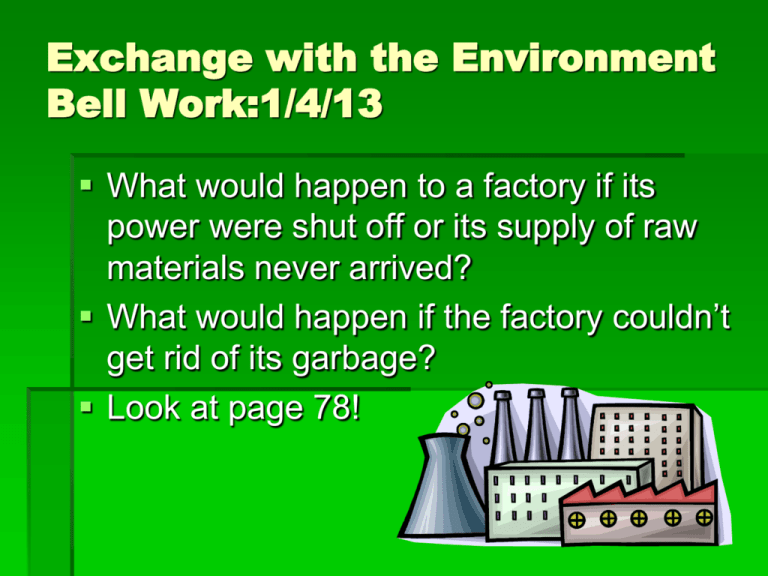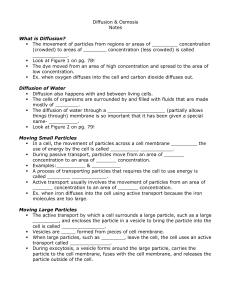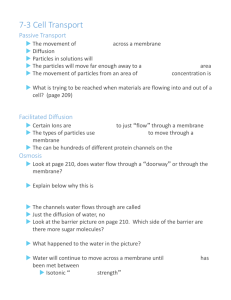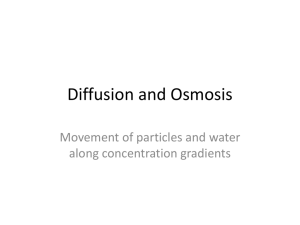What is Diffusion?
advertisement

Exchange with the Environment Bell Work:1/4/13 What would happen to a factory if its power were shut off or its supply of raw materials never arrived? What would happen if the factory couldn’t get rid of its garbage? Look at page 78! Objectives Explain how materials move through simple diffusion. (SPI 0707.1.5) Diffusion/Osmosis Demo, Lab, & Notes Table of Contents: 62. Diffusion and Osmosis Notes Challenge Question? What cell organelle allows things to move in and out of the cell? What things are allowed in and out of the cell? Discuss the questions with your Elbow Partner. Blowing Bubbles • Soap bubbles have properties, such as flexibility, that are similar to cell membranes. • Components of soap film and of cell membranes move around freely because they are made of proteins and lipids (fats). What is Diffusion? The movement of particles from regions or areas of _________ concentration high (crowded) to areas of ________ low concentration (less crowded) is called ____________. diffusion Look at Figure 1 on pg. 78! The dye moved from an area of high concentration and spread to the area of low concentration. Ex: when oxygen diffuses into the cell and carbon dioxide diffuses out. Diffusion of Water Diffusion also happens with and between living cells. The cells of organisms are surrounded by and filled with fluids that are made mostly of ________. water The diffusion of water through a _____________ semipermeable (partially allows things through) membrane is so important that it has been given a special name__________. osmosis Look at Figure 2 on pg. 79! Question...Elbow Partner In diffusion and osmosis, why do the particles move from areas that are more crowded to areas that are less crowded? For a cell to survive, the amount of molecules need to be the same on both sides of the cell membrane. If the cell does not pump out all of its extras to even things out, this could be very bad. The cell can swell up and explode. Listen to this… Moving Small Particles In a cell, the movement of particles across a cell membrane _________ without the use of energy by the cell is called __________ passive ___________. transport During passive transport, particles move from an area of _______ high concentration to an area of _______ low concentration. Diffusion & __________ Osmosis Examples:__________ A process of transporting particles that requires the cell to use energy is called ________ active ____________. transport Active transport usually involves the movement of particles from an area of _______ low concentration to an area of _______ concentration. high This happens a lot in neurons. The membrane proteins are constantly pumping ions (atoms or molecules that have a + or – electrical charge) in and out to get the membrane of the neuron ready to transmit electrical impulses. Moving Large Particles The active transport by which a cell surrounds a large particle, such as a large _________, protein and encloses the particle in a vesicle to bring the particle into the cell is called _______________. endocytosis sacs formed from pieces of cell Vesicles are _____ membrane. Ex: when iron diffuses into the cell using active transport because the iron molecules are too large. wastes leave the When large particles, such as ________, cell, the cell uses an active transport called ______________. exocytosis During exocytosis, a vesicle forms around the large particle, carries the particle to the cell membrane, fuses with the cell membrane, and releases the particle outside of the cell. What do you know? Describe how each of the following materials would get through the cell membrane and into a cell: 1. Pure water (osmosis) 2. Sugar entering a cell that already contains a high concentration of particles (active transport) 3. Sugar entering a cell that has a low concentration of particles (passive transport) 4. A protein (endocytosis) Diffusion Lab 1. Fill beaker halfway with water. Teacher will add 20 drops of iodine to the water. 2. CAREFULLY place two heaping spoonfuls of cornstarch into a plastic bag. 3. CAREFULLY add 25 ml of water in the bag of cornstarch, keeping solution in the corner of the bag. Seal the bag. Move the corner of the bag between your fingers to mix the cornstarch and water together. 4. Place the bag in the beaker and wait. 5. Check the bag and record your observations after 5, 10, and 15 minutes. 6. While waiting, fill out the lab paper, both front and back. If you don’t finish, it will be homework. Diffusion Lab Questions 1. The plastic bag is semipermeable to which substance? 2. Why did the iodine enter the bag? 3. Why didn’t the starch enter the beaker? 4. How is the plastic bag like the cell membrane? 5. What is the definition of the word “diffusion”?




